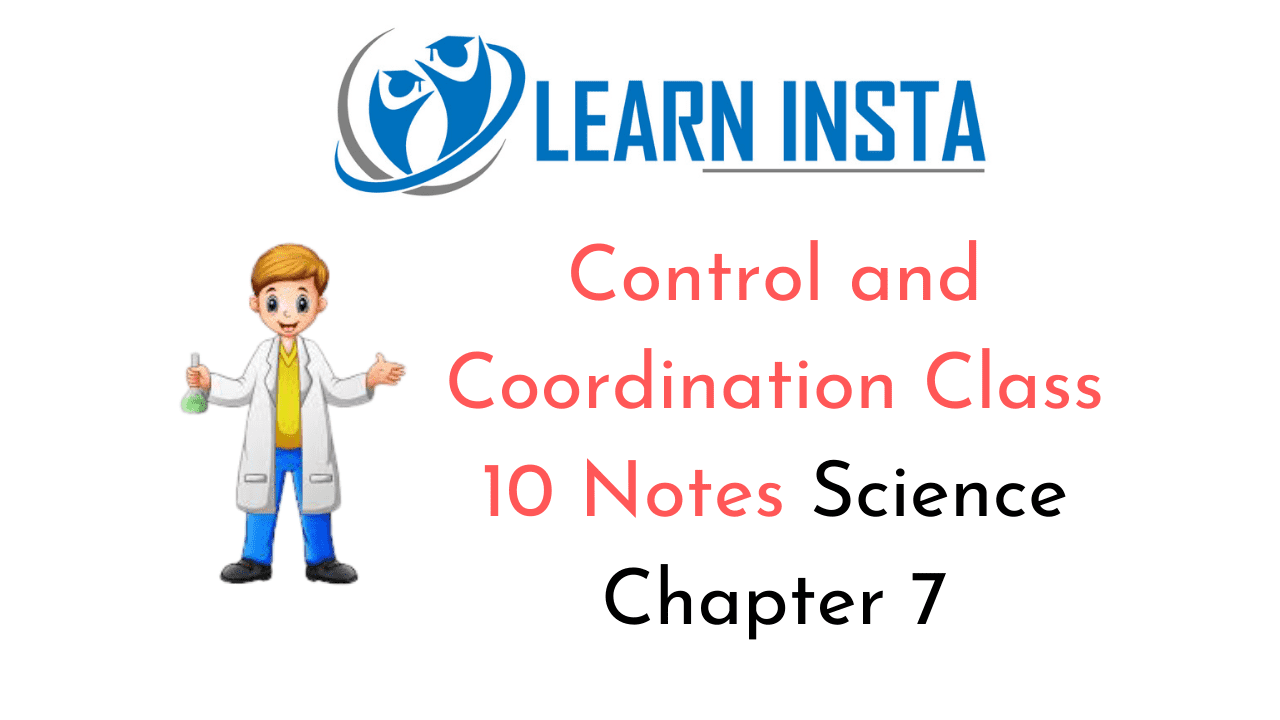 On this page, you will find Control and Coordination Class 10 Notes Science Chapter 7 Pdf free download. CBSE NCERT Class 10 Science Notes Chapter 7 Control and Coordination will seemingly help them to revise the important concepts in less time.
On this page, you will find Control and Coordination Class 10 Notes Science Chapter 7 Pdf free download. CBSE NCERT Class 10 Science Notes Chapter 7 Control and Coordination will seemingly help them to revise the important concepts in less time.
CBSE Class 10 Science Chapter 7 Notes Control and Coordination
Control and Coordination Class 10 Notes Understanding the Lesson
1.Growth related movements: A seed germinates and grows and seedling comes out by pushing the soil aside. Such a movement is related to growth as these movements would not happen if growth of seedling is stopped.
2. Growth unrelated movements: A cat running, children playing on swings, buffaloes chewing cud – these are not movements caused by growth. These are growth independent movements. When we touch the leaves of a chhui-mui (the ‘sensitive’ or ‘touch-me-not’ plant of the Mimosa family), they begin to fold up and droop. This movement of its leaves are independent of growth.
3. Movement is an attempt by living organisms to use changes in their environment to their advantage: Plants grow to get sunshine. Buffaloes chew cud to enable digestion of tough food. Swinging gives pleasure to the children. We try to protect ourselves by detecting the change in the environment and showing movement.
4. Control and coordination in animals is regulated by two systems: Nervous system and hormonal system.
5. Animals – Nervous System
The specialised tips of some nerve cells detect all information from our environment with help of receptors usually located in our sense organs, such as the inner ear, the nose, the tongue, etc. Gustatory receptors: Detect taste (present on tongue).
6. Olfactory receptors: Detect smell (present in nose).
7. Stimulus: Any agent, factor, chemical or change in external or internal environment which elicits reaction in an organism.
8. Response: A change in an organism (an action) resulting from a stimulus.
9. Mode of transmission of nerve impulse:
- An electrical impulse is generated when information is acquired at the end of the dendritic tip of a nerve cell.
- This impulse travels from the dendrite to the cell body, and then along the axon to its end.
- At the end of the axon, the electrical impulse sets off the release of some chemicals called neurotransmitters at synapse. Synapse is the junction between two neurons where axon ending of one neuron is placed close to dendrites of the next neuron.
- These chemicals (neurotransmitters) cross the synapse, and start a similar electrical impulse in a dendrite of the next neuron.
- A similar synapse finally allows delivery of such impulses from neurons to effectors.
10. Effectors are muscles, glands, tissues, cells, etc., which respond to the stimulus received from nervous system.
Nervous tissue is made up of an organised network of nerve cells or neurons, and is specialised for conducting information via electrical impulses from one part of the body to another. Neuron (Nerve cell) is the structural and functional unit of the nervous system.
11. Parts of a neuron
- where information is acquired—Dendrites
- through which information travels as an electrical impulse—Axon
- Impulse converted into a chemical signal for onward transmission—Synapse.

12. Reflex Action and Reflex Arc
(i) A reflex action is a spontaneous, autonomic and mechanical response to a stimulus controlled by the spinal cord without the involvement of brain.
(ii) In such reactions we do something without thinking about it, or without feeling in control of our reactions. Reflex actions are very fast response of nervous system to dangerous situations. Example: We withdraw our hand immediately if we prick our finger or touch a hot object.
(iii) Reflex actions are involuntary actions as they cannot be controlled as per our will. They occur automatically.
(iv) The stimulus received by receptors present on sense organ is sent through sensory neuron to spinal cord. Spinal cord sends messages through motor neuron to muscles (effectors) to cause movement of the part and avoid damage. The arc formed in such case is called as the reflex arc.
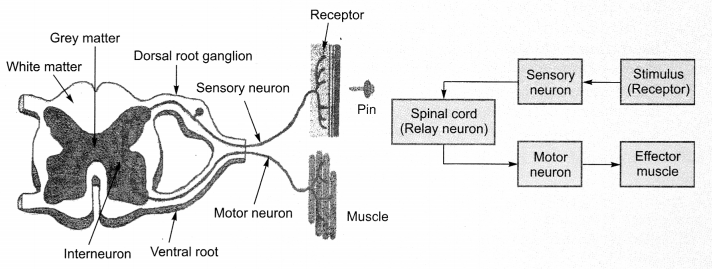
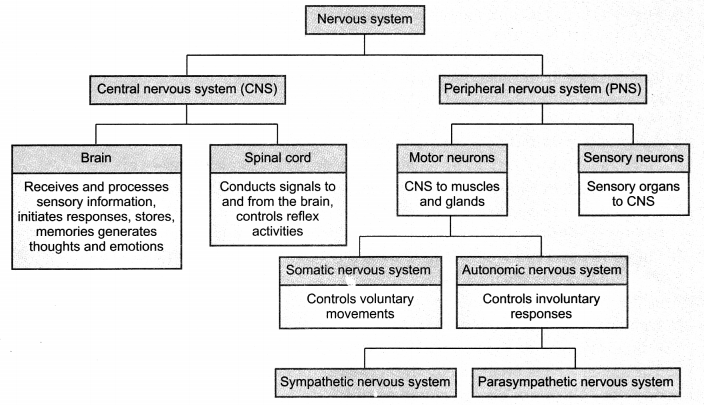
13. Human Brain
- Brain is the main coordinating centre of the body.
- The brain and spinal cord constitute the central nervous system and are composed of nerves.
- They receive information from all parts of the body and integrate it.
- The communication between the central nervous system and the other parts of the body is facilitated by the peripheral nervous system.
- The nerves arising from the brain (cranial nerves) and nerves arising from spinal cord (spinal nerves) constitute the peripheral nervous system.
- The brain allows us to think and take actions based on that thinking.
- The actions based on our will are called voluntary actions. Example: Writing, talking, clapping at the end of a programme.
- Brain also sends messages to muscles. This is the second way in which nervous system communicates with muscles.
14. Parts of Brain:
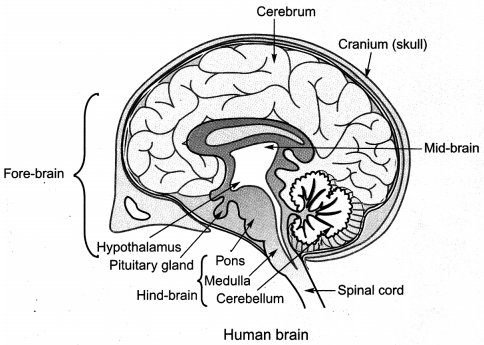
- The brain has three major parts/regions: fore-brain, mid-brain and hind-brain.
- The fore-brain is the main thinking part of the brain. It has regions (sensory area) which receive sensory impulses from various receptors. Separate areas of the fore-brain are specialised for hearing (auditory area), smell (olfactory area), and sight (optic area) and so on.
- There are separate association areas where this sensory information is interpreted by putting it together with information from other receptors as well as with information that is already stored in brain.
- A separate part of fore-brain associated with hunger gives a sensation of feeling full.
- Many involuntary actions are controlled by mid-brain and hind-brain.
- Hind-brain comprises of cerebellum, pons and medulla oblongata.
- Cerebellum is responsible for precision of voluntary actions and maintaining the posture and balance of the body. Activities like walking in a straight line, riding a bicycle, picking up a pencil.
- Pons connects cerebellum and medulla oblongata and helps in regulation of respiration rate.
- Medulla controls the involuntary actions like blood pressure, salivation and vomiting.
15. Protection of Brain and spinal cord
- Human brain is present inside a bony box called skull or cranium.
- A fluid-filled inside the skull called cerebrospinal fluid, helps in shock absorption.
- The spinal cord is protected by the vertebral column.
16. How does the Nervous Tissue cause Action?
Muscle cells have contractile proteins, actin and myosin which change both their shape (by getting shortened) and their arrangement in the cell in response to nervous electrical impulses received by them. This results in movement of the part of the body.
17. Coordination in Plants
The touch-me-not plant moves its leaves in response to touch as its cells change shape by changing the amount of water in them, resulting in swelling or shrinking. Such movement is growth independent movement.
18. Movement Due to Growth: Pea plant climbs up by means of tendrils which are sensitive to touch. The part of the tendril in contact with the object does not grow as rapidly as the part of the tendril away from the object. This causes the tendril to circle around the object and thus cling to it.
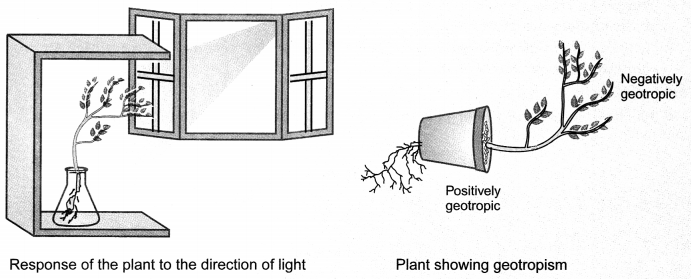
19. Tropism/Tropic movements: Movements in plants which occur in direction of the stimulus. They are directional movements. These directional, or tropic, movements can be either towards the stimulus, or away from it.
20. Phototropism: Growth of plant in response to light. Shoots respond by bending towards light while roots respond by bending away from it.
21. Geotropism: Growth of plant in response to gravity. The roots of a plant always grow downwards while the shoots usually grow upwards and away from the Earth.
22. Hydrotropism: Growth of plant in response to water. Roots always grow towards water and show hydrotropism.
23. Chemotropism: Growth of plant in response to chemicals. Example: Growth of pollen tubes towards ovules.
24. Thigmotropism: Growth of plant in response to touch. Example: Climbers coil around support.
25. Limitations to the use of electrical impulses
Firstly, they do not reach each and every cell in the animal body. They reach only those cells that are connected by nervous tissue.
Secondly, the cell takes some time to reset its mechanisms before it can generate and transmit a new impulse. They cannot continually create and transmit electrical impulses.
26. Way to overcome limitations to the use of electrical impulses
Most multicellular organisms use chemical communication to overcome the limitations of electrical impulse. Chemical compounds (hormones) released by stimulated cells diffuses all around it and is detected by other cells with help of special molecules on their surfaces.
27. How do Plants coordinate their activity?
Plants do not have nervous system. They respond to stimuli with help of chemicals called as plant growth regulators or plant hormones like auxin, gibberelin, cytokinin, abscissic acid, etc.
28. Auxin: It is synthesised at shoot tips and helps in bending of plant towards light. When light comes from one side of the plant, auxin diffuses towards the shady side of shoot. This higher concentration of auxin stimulates the cells to grow longer on the side of shoot which is away from light. Thus, plant appears to bend towards light.
29. Gibberellins: They help in the growth of the stem.
30. Cytokinins: This hormone promotes cell division. It occurs in higher concentration in areas of rapid cell division, such as in fruits and seeds.
31. Ethylene: It is a gaseous hormone which helps in ripening of fruits.
32. Abscissic acid: This hormone inhibits growth. Its effects include wilting of leaves. It is also called as stress hormone as it helps to overcome stress conditions.
33. Hormones in Animals
Hormones are non-nutrient chemicals which act as intercellular messengers, are produced in trace amounts, directly poured in the blood stream and act only on a specific target organ. They are secreted by endocrine glands (ductless glands).
34. Functions of Animal Hormones:
(i) Thyroxin hormone: Iodine is necessary for the thyroid gland to make thyroxin hormone. Thyroxin regulates carbohydrate, protein and fat metabolism in the body so as to provide the best balance for growth. Iodine is essential for the synthesis of thyroxin. In case iodine is deficient in our diet, there is a possibility that we might suffer from goitre. One of the symptoms in this disease is a swollen neck.
(ii) Adrenaline hormone: It is secreted by adrenal gland in response to stress of any kind and during emergency situations fear, joy, emotional stress, etc. Adrenaline increases breathing rate and the blood supply to heart and muscles. It constricts arterioles. Its target organ is heart and arteries. It is also called as emergency hormone or stress hormone.
(iii) Growth hormone is secreted by the anterior pituitary gland. If there is a deficiency of this hormone in childhood, it leads to dwarfism. Its excess causes gigantism.
(iv) Testosterone in males secreted by testis and oestrogen in females secreted by ovary causes changes in body of males and females during puberty.
(v) Insulin hormone is produced by the pancreas and helps in regulating blood sugar levels. Its deficiency causes diabetes due to increase in blood glucose level.
35. Feedback Mechanisms:
The timing and amount of hormone released are regulated by feedback mechanisms. For example, if the blood glucose level rises, it is detected by the cells of the pancreas which respond by producing more insulin to promote absorption of glucose and formation of glycogen in liver and muscles. When the blood sugar level falls and comes to normal, insulin secretion is stopped by the pancreas.
Class 10 Science Chapter 7 Notes Important Terms
Gustatory receptors: The receptors present in the tongue which help to detect taste.
Olfactory receptors: The receptors present in the nose which help to detect smell.
Neuron (Nerve cell): It is the structural and functional unit of the nervous system.
Synapse: The junction between the two neurons which helps to transmit the electrical or chemical signal to the next neuron.
Reflex action: A reflex action is a spontaneous, autonomic and mechanical response to a stimulus controlled by the spinal cord without the involvement of brain.
Tropism/Tropic movements: Tropism is a growth movement whose direction is determined by the direction from which the stimulus strikes the plant.
- Positive = Growth towards the stimulus
- Negative = growth away from the stimulus.
Phototropism: The response of a plant or its part to light. Roots are negatively phototropic while shoots are positively phototropic.
Geotropism: The response of a plant or its part to gravity. Roots are positively geotropic while shoots are negatively geotropic.
Hydrotropism: The response of a plant or its part to water. Roots always grow towards water and show positive hydrotropism.
Chemotropism: The response of a plant or its part to chemical stimulus. Pollen tubes grow towards ovule due to chemicals secreted by them.
Thigmotropism: The response of a plant or its part to stimulus of touch.
Hormones: Hormones are chemical messengers that are secreted directly into the blood, which carries them to the specific target organs and tissues of the body to exert their functions.